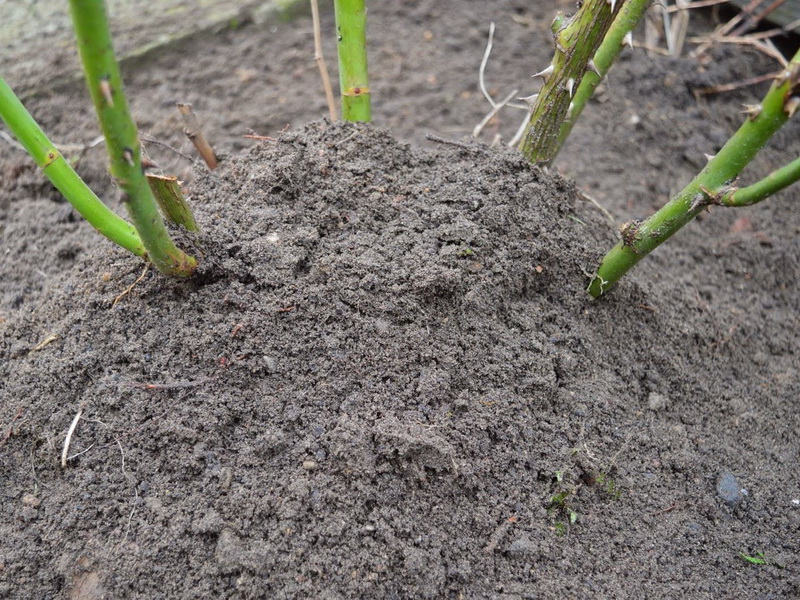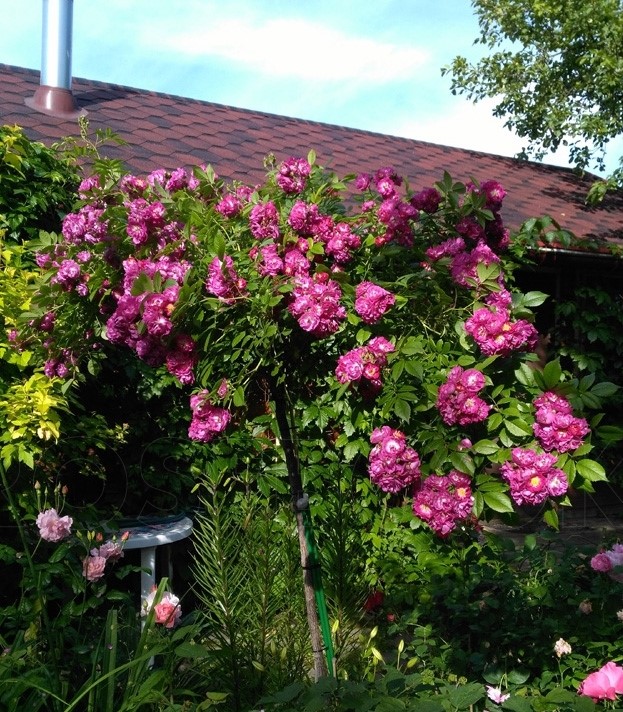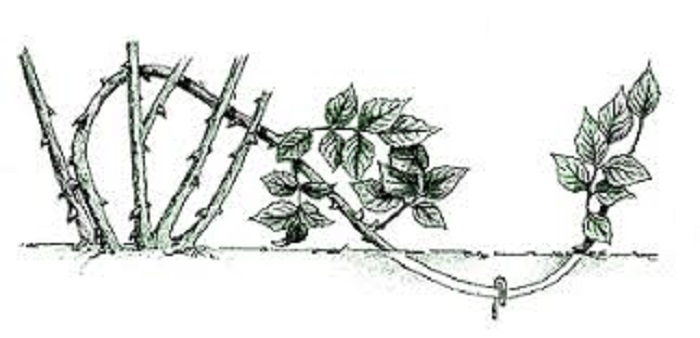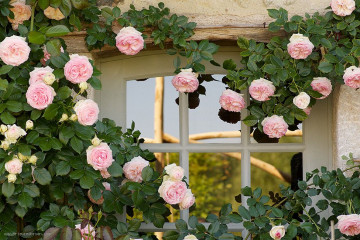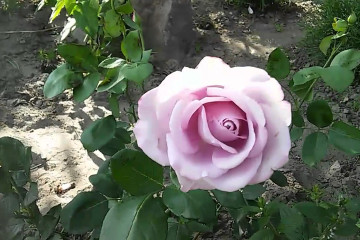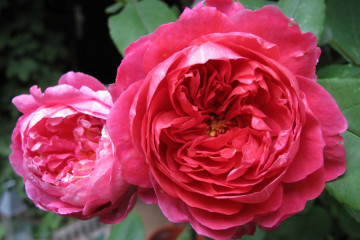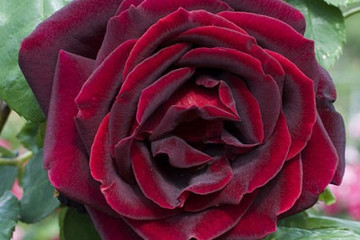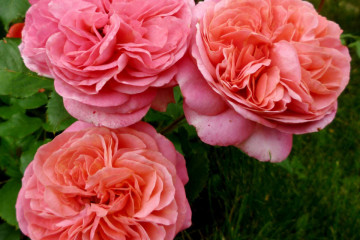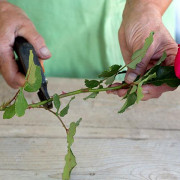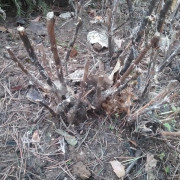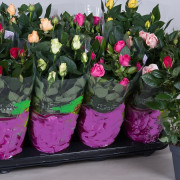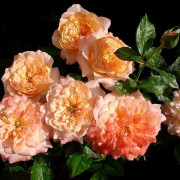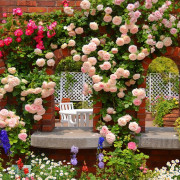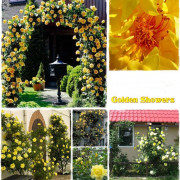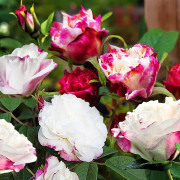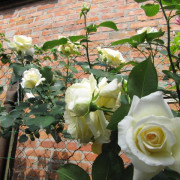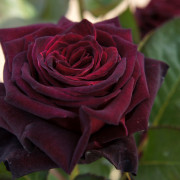Rose Perennial Blue - variety description
Content:
Climbing roses are used for vertical gardening of the site. One of the best varieties of culture in this regard is Perennial Blue, capable of decorating the territory with its lilac-purple inflorescences. Below is detailed information on growing a rambler in a garden plot.
Rose Perennial Blue - what is this variety
The variety is a product of the selection of English specialists. The climbing rose was bred in 2003, and already in 2006 it won a prize at a competition in Baden-Baden.
Lilac-purple inflorescences are evenly distributed throughout the plantation. The rose is known under several names: Perennial Blue, Mehblue, Mehv 9601.
Short description
The bushes reach a height of 2-3 m, spread out in width up to 2 m. Inflorescences are formed on the stem, consisting of 5-10 flowers. There are no thorns on the shoots or there are few of them. In full disclosure, the diameter of the bud is 3-4 cm. Semi-double lilac-purple flowers thin out the sweet aroma. Bushes can be formed in the form of a trunk.
Advantages and disadvantages of the variety
The advantages of a climbing rose include the following qualities:
- the ability to re-bloom;
- decorative look;
- good immunity;
- easy to shape;
- adaptability to local climatic conditions.
The disadvantages include the burnout of flowers when the bright rays of the sun hit them.
Use in landscape design
Perennial Blue bushes will look beautiful when planted alone. When planting plants close together, you can create a hedge. The rose will serve as a vertical in landscape design, planted near pillars, columns, trees, and other supports.
Growing a flower
It is not difficult to grow a decorative rose if you follow the rules of agricultural technology correctly. It is better to purchase shrubs in a garden plant nursery, where they were taken care of from the very beginning, the culture required. Before buying, seedlings are carefully examined: they should not show signs of disease and pest damage.
In what form is the landing
Young bushes 1-2 years old are planted on the site. They are grown independently from cuttings or purchased in a garden center, nursery. Choose healthy seedlings with a well-branched root system.
What time is it carried out
Plants are planted in the spring after the threat of frost has passed. This period is preferable for cold regions: the bushes have time to adapt before the onset of frost. In warm areas, the rose can also be planted in the fall.
Seat selection
Rambler develop well in a brightly lit area without cold winds blowing. On a hot afternoon, they should be shaded, otherwise the petals will burn out under the scorching rays of the sun.
How to prepare a flower and soil
The site is dug up, if necessary, deoxidizing substances are introduced into the soil: lime, dolomite flour. If the soil is alkaline, it is diluted with peat. The rose is shortened to 2-4 buds, the root system is cut by 1 cm. The roots that have dried up during transportation are dipped for 10-12 hours in warm water.
Planting procedure step by step
The bushes are planted as follows:
- Dig holes 70 cm wide and 60 cm deep.
- A layer of expanded clay or small stones is laid out on the bottom.
- Then sprinkle with fertile soil.
- A seedling is installed, covered with soil above the root collar.
- Compaction of the earth, watering.
Plant care
The rose needs constant care. It needs to be watered periodically, fed, and the grass growing around the bushes must be removed. Mulching will help keep moisture in the soil. Formative and sanitary pruning is performed throughout the season.
Watering rules and humidity
Watering frequency depends on the soil. Sandy loam soil dries faster than loam, so it is moistened more often. The top layer of the earth should have time to dry out between waterings.
Top dressing and soil quality
The decorative appearance of the climbing rose Perennial Blue largely depends on the fertility of the soil. Every year the land is depleted, so constant feeding is required. Nitrogen fertilizers are applied in the spring, and a complex mineral composition in the summer. After flowering, the bushes are fed with potassium and phosphorus for laying flower buds for the next year, as well as for a safe wintering.
Pruning and replanting
Sanitary and formative pruning is performed every year. Broken, diseased branches are removed throughout the season. After flowering, the buds are cut, taking away the forces necessary for the further development of the bushes. In the fall, unripe shoots are cut out, whips are shortened.
Features of wintering a flower
To make the Perennial Blue rose easier to endure the frosty winter, it is watered abundantly in late autumn. When the air temperature begins to drop to minus indicators, the bushes are spudded, if necessary, they are covered. The procedure cannot be carried out in advance due to the threat of damping out of the roots and shoots.
Blooming rose
Inflorescences are formed both on young shoots and on old branches. Due to this feature, a play of shades from lilac-pink to lilac-purple is achieved. The stems of the rose are flexible, of which it is easy to form bushes of various configurations.
A period of activity and rest
The flowering of the plant begins in May, but the bushes are especially decorative in July.
Care during and after flowering
If the weather is dry and hot, the bushes are watered abundantly. When the inflorescences begin to wither, they must be removed. If this is not done, then baskets with seeds will begin to form, and the formation of new buds will be difficult. After flowering, the bushes are fed with potassium-phosphorus fertilizers.
What to do if it does not bloom
Rose blooming is difficult for the following reasons:
- the bushes are too young. In the year of planting, the plants may not begin to bloom, and if buds begin to form, it is better to remove them: the roses must first take root well, build up the green mass;
- the impact of climatic conditions. In dry hot weather, especially with a lack of moisture, the bushes can grow underdeveloped inflorescences that do not have time to bloom. Plants need watering at least 1 time per week;
- the root collar is too deep or, conversely, is too close to the soil surface. The vaccination site must be at least 10 cm deep;
- shoots are not pruned. After the first wave of flowering, the inflorescences with fragments of stems are cut off, otherwise the re-formation of buds may not occur;
- unsuitable landing site. Roses love direct sunlight in the morning and evening. At noon, the bushes should be shaded. When planting roses in a damp, dark place blown by cold winds, it will not be easy for inflorescences to form.
Flower propagation
A gardener can breed a climbing rose on his site in several ways: by cuttings, grafting, dividing the bush, layering. With the latter method, it is especially easy to propagate the culture due to long lashes that easily descend to the surface of the soil.
Most often, the rose is propagated in the spring. This period is favorable because young bushes have enough time to develop before the onset of cold weather. A rose grown in a container can be planted on the site at any time along with a lump of earth.
Reproduction of a rose by layering is carried out as follows:
- Make a groove perpendicular to the bush.
- Watered, put the lower whip of roses in it.
- Pinned, covered with earth.
In summer, the place of contact of the shoot with the ground is watered, the earth is loosened around it, and weeds are removed. When young shoots germinate and strengthen from the cuttings, they are separated from the mother plant and planted in a permanent place.
Diseases, pests and ways to control them
Climbing roses have good immunity, are rarely affected by diseases and pests. This can happen due to contaminated land, insufficient or, conversely, excessive watering. When diseases are detected, the bushes are sprayed with fungicides. They get rid of harmful insects with the help of insecticides.
Climbing roses have a great advantage over other types of culture. They can be used for vertical gardening of the garden, planting near the supports, gazebos, putting them on the arch. It is such a rose that Perennial Blue is, whose lilac-purple inflorescences can be used to decorate any local area.


